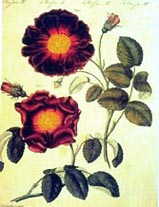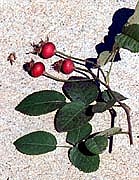class: Gallica Rose
synonyms: R. gallica violacea, R. gallica 'Violacea', La Belle Sultane
breeding: Cumberland, v. 1824
photographed by Daphne Filiberti in her garden
The research of Anny Jacob, Hedi and Wernt Grimm, and Bruno Müller reveals that a subclass of
Gallicas, known as Rosa gallica var. holosericea, sometimes referred to as the "roses de
velours", was known around 1600. John Parkinson described Rosa holoserica simplex and multiplex, or the single and double Velvet Rose, in Paradisi in Sole: Paradisus Terrestris in 1629:
"The old stemme and stock of the velvet Rose is covered with a dark coloured barke, and the young shootes of a sad greene with very few or no thornes at all upon them: the leaves are of a sadder greene colour than in most sorts of Roses, and very often seven on a stalke, many of the rest having but five: the rose is either single or double: the single is a broade spread flower, consisting of five or six broade leaves (petals) with many yellow threds in the middle: the double hath two rowes of leaves (petals), the one large, which are outermost, the other smaller within, of a very deepe red crimson colour like unto crimson velvet, with many
yellow threds also in the middle; and yet for all the double rowe of leaves, these Roses stand but like single flowers: but there is another double kinde that is more double than this last, consisting oftentimes of fifteene leaves (petals) or more in a flower, and most of them of an equall bignesse, of the colour of the first single rose of this kinde, or
somewhat fresher; but all of them of a smaller scent than the ordinary red Rose."
C. G. Rössig later described the subclass of roses between the years of 1799
and 1803. The roses de velours whether simple, semi-double, or double, were characterized by
their strong coloring, often violet. Rössig named a variety with ten petals Rosa violacea. A
picture of Rosa holosericea flore semiplena has been maintained from a children's book dated to
the approximate date, 1795, of Rössig's descriptions (A picture of this rose will follow in the
chart below). Hedi Grimm noted this picture was Rosa gallica 'Violacea'.
The work of Dr. Hedi Grimm reveals that the rose grown in our gardens today, and sold as La Belle
Sultane, is Violacea and other synonyms (Maheka, Rose du Serail, Rose Sultane, Sultane, and
Cumberland) are not substantiated. François Joyaux states that La Belle Sultane is most
likely extinct; however, Violacea is a close approximation for that rose. François Joyaux believes that Du Pont probably brought the roses into France. He has stated that
La Belle Sultane has become an admissible name for Violacea, although incorrect.
Some differences between Violacea and La Belle Sultane are explained (click on the roses to see a larger illustration):
 Dr. Hedi Grimm labeled the rose to the left Rosa holosericea
flore semiplena, or Violacea. It is the rose that survives in our gardens today. The illustration of the rose was taken from a children's book
dated 1795. There is a notation that the rose's name is "Die halbgefüllte Purpur-Samtrose". This is believed to be the
rose that Rössig named Rosa Violacea. Dr. Hedi Grimm labeled the rose to the left Rosa holosericea
flore semiplena, or Violacea. It is the rose that survives in our gardens today. The illustration of the rose was taken from a children's book
dated 1795. There is a notation that the rose's name is "Die halbgefüllte Purpur-Samtrose". This is believed to be the
rose that Rössig named Rosa Violacea.
|
| A third form of the rose, which was more complex and had more petals, is described by Graham Thomas. This rose was named Rosa holoserica duplex
by Rössig. François Joyaux states that this rose is also extinct, and probably corresponds to the Rosa gallica maheka (flore multiplici) of
Redouté. The most complex form of the rose was known as Maheka, Rose Sultane and Rose du Serail.
An interesting note is that the petals of these roses do range in number. Gwen Fagan cites a seedling of Mrs.
Knox Shaw's Violacea which is single and a lot like Rosa gallica. The hips of Violacea are also very similar
to those of Rosa gallica.
 Violacea doesn't appear to be a pure Gallica because it has a tendency to grow larger than what
is typical of Gallicas. Graham Thomas commented that the rose has tendencies that are found in both Centifolias and Damasks. In his Gardeners Dictionary of 1768, Philip Miller wrote that he raised a single Velvet Rose, a double Velvet Rose, and a Royal Velvet Rose from the seeds of the pale Provence Rose. Violacea doesn't appear to be a pure Gallica because it has a tendency to grow larger than what
is typical of Gallicas. Graham Thomas commented that the rose has tendencies that are found in both Centifolias and Damasks. In his Gardeners Dictionary of 1768, Philip Miller wrote that he raised a single Velvet Rose, a double Velvet Rose, and a Royal Velvet Rose from the seeds of the pale Provence Rose.
Violacea has round leathery leaves that turn to wonderful warm colors in the autumn.
I have heard that the rose does well in frost. It is always in good health. Here in Southern
California, I have eight roses which are over seven feet high and are self-pegged. At first they seemed stiff and
unaccommodating, but they have responded well. They blend nicely with the colors of Tuscany Superb or Cardinal de
Richelieu. I have planted a mass of Viola Tricolor at their feet.
There is a book that I can recommend named Roses Anciennes et Roses Sauvages by Anny Jacob, Hedi and Wernt Grimm, and Bruno Müller. It has been translated into French from German. I purchased mine from the publisher in Paris at:
Editions Ulmer. Hedi and her husband Wernt Grimm were very instrumental in creating the historic rose garden at Wilhelmshöhe, Germany.
©2000-2005 Daphne Filiberti
Photo of Violacea from a children's book used by permission of Dr. Hedi Grimm
www.RoseGathering.com
|













